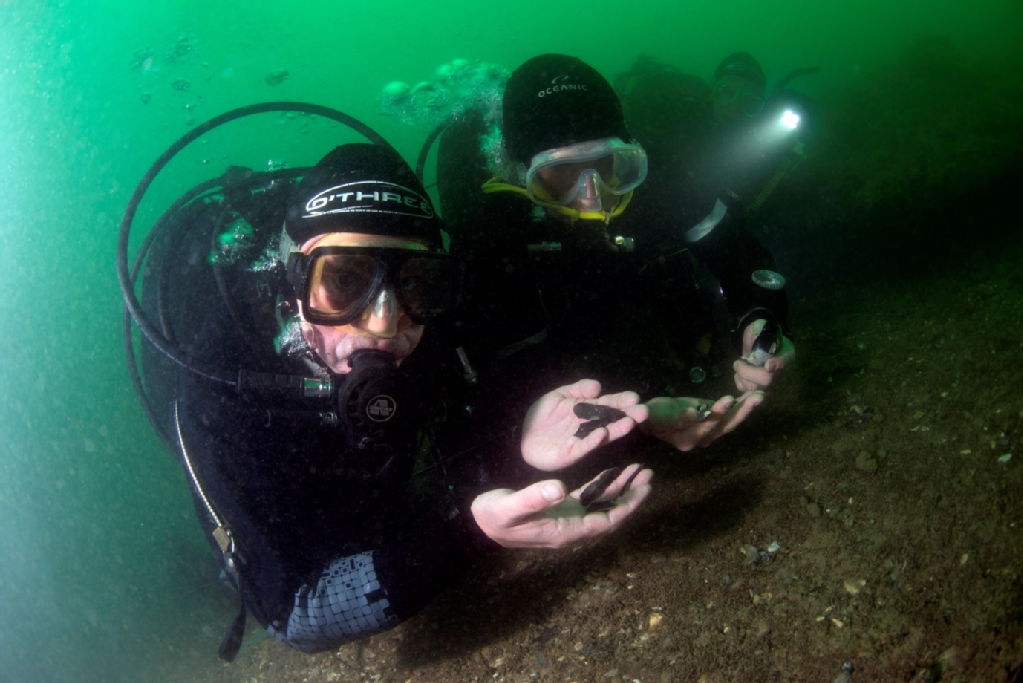Changing perceptions of Britain from the Mesolithic to Neolithic age
The Mesolithic-to-Neolithic transition marked a profound change in human society as a hunter-gatherer economy gave way to agriculture and the development of complex societies. In Northern Europe, this coincided with rising sea levels which cut Britain off from the continental mainland. Professor Robin Allaby from Warwick’s Department of Life Sciences explains his new research which challenges the traditional evaluation of the development of early British man.
Where has your research taken you recently?
Under the sea! I’ve been working with colleagues at the School of Life Sciences and Warwick Medical School, together with academics from the University of Bradford, the Maritime Archaeology Trust, the University of St Andrews and the University of Birmingham. We have been looking at the sedimentary DNA taken from Bouldnor Cliff, an underwater site in the Solent, the strait that separates the Isle of Wight from the mainland of England. We’ve discovered that all is not what it seems when it comes to how archaeologists have traditionally evaluated the development of early British man.
What’s so special about Bouldnor Cliff?
Around 8,000 years ago, Britain had a land crossing to France and the Netherlands and the site that is now preserved under water was actually a river valley. It’s an absolutely fascinating site holding artefacts with a technical sophistication 2,000 years earlier than expected from mainland British archaeology. Many of these artefacts suggest that the people in the area were connected to more advanced groups from Europe who shared their technology or at least had it copied. For example, there is evidence of a boatbuilding industry on Bouldnor Cliff, which predates similar instances in mainland Britain by 2,000 years. And the flints found there more closely resemble those discovered in northern France. The site is part of the Solent Maritime Special Area of Conservation, and can be found 250 metres off the village of Bouldnor on the Isle of Wight, 11 metres underwater. It’s particularly special because under the sea things are kept in a constant 4°C environment, perfect for preserving, in a kind of “nature’s fridge”. Ancient DNA biomolecules have survived under the sea, when on dry land, they would normally have been destroyed by the passing of the years. So we’re able to collect all sorts of new samples, run new tests and literally unearth new findings about how early man may have lived.
What’s the history of the site? Is it true that a lobster had an important part to play?

That is true! Work started in earnest on the site in 1999, when divers from the Hampshire and Wight Trust for Maritime Archaeology noticed that a lobster was spring cleaning its burrow. On closer inspection it was revealed that he was chucking out Mesolithic worked flint artefacts from the burrow he had made in the thick mud that had built up since the Solent was first flooded all those years ago. The lobster had tunnelled into what 8,000 years ago would have been a land surface above sea level. But in fact, wood and flint tools were being brought up from the sea by fishermen as far back as the 1960s.
We discovered the remains of wheat among the grasses at the site. Wheat was not seen on the British mainland for another 2,000 years, when the Neolithic age was in full swing...
So, what was happening 8,000 years ago?
To be precise, the Mesolithic-to-Neolithic transition was happening. This shift marked a profound change in human society. Archaeologists have discovered that between 6,000 and 4,000BC, having once led a hunter-gatherer existence, we turned to agriculture and our more complex societies developed. We started farming arable crops such as einkorn, emmer and barley. At this time, a period of rapid sea rise caused by the melting of prehistoric glaciers also occurred, inundating large areas of land connecting Britain to France and the Netherlands, forming the English Channel and much of the North Sea. So, global warming was changing the world all those years ago, as it is today!
Did the water appear in a Noah-esque flood or a trickle building up over many years?
We know the inundation happened over a period of about 30-100 years. We estimate that the water rose sometime around the years 6010BC to 5940BC. But it’s hard to pin anything down definitely.
So, you had to go underwater to collect evidence. What did you want to achieve?
The team wanted to understand exactly what was going on at the site before it was submerged. How were its inhabitants managing or farming the environment? What were their habits? Can we classify the societies present there as Mesolithic (hunter-gatherer) or Neolithic (agricultural). As I’ve mentioned, what was going on at Bouldnor Cliff was 2,000 years more advanced, technologically speaking, than what was happening all over the rest of Britain. Analysing and reconstructing floral and faunal changes going on while the site was occupied, together with artefacts such as tools and weapons, is the best way to gauge what the humans were up to.
How did you extract the DNA from under the water?

Samples were taken by thrusting metal sampling boxes into freshly exposed solid sediment to remove a brick of the ancient soil, or palaeosol, which was then immediately sealed and transported to the surface of the sea. Warwick has a great ancient DNA lab that’s positively pressured and has an ante-chamber for restricted access to ensure the samples are not damaged. In the laboratory, subsamples of sediment were cut from the centre of the brick, examined for macrofossils and subjected to ancient DNA extraction in a dedicated laboratory following standard ancient DNA protocols.
Our project highlights the need for further subaquatic research. There’s still lots to discover, so I’ll be reaching for the scuba mask sooner, rather than later
What was found in the soil?
We unearthed DNA belonging to dogs, cows and bulls, deer, grouse and rodents. The landscape appeared to be made up of woodland including oak, poplar, apple and probably alder trees, together with grasses and herbs. So far, so Mesolithic! However, we also discovered the remains of wheat among the grasses. Wheat was not seen on the British mainland for another 2,000 years, when the Neolithic age was in full swing. In the samples we examined there was no evidence for established cultivation of the wheat, suggesting that it had had its origins on the continent. However, the presence of pioneering technological artefacts at the site as a whole, such as the boats and flints mentioned earlier, provides evidence that a social network may have existed between the Mesolithic peoples of north-western Europe and the advancing Neolithic front in Southern Europe. And that the inhabitants of Bouldnor Cliff were the first to get their hands on the technology.
What were the implications of these results?
The evidence fully supported our hypothesis that the earliest stages of Neolithisation in the British Isles occurred in lowland regions such as Bouldnor Cliff. Our research throws doubt on the traditional view that the British Neolithic age started 6,000 years ago. It certainly appears that the people who occupied Bouldnor Cliff were in the process of Neolithisation 8,000 years ago. But it also means that Britain was not as isolated and insular as previously thought, that its people were possibly connecting with their nearest neighbours on the continent.
What’s next?
More research! Our project highlights the need for further subaquatic research into the networks that linked Britain to Europe. There’s still lots to discover about trade links which may have existed between Britain and Europe, and how the inhabitants may have used the land before it was submerged. So I’ll be reaching for the scuba mask sooner, rather than later.
Published
February 2015
 Robin Allaby is Professor at the University of Warwick's School of Life Sciences. His key interests are plant evolutionary genetics; evolution of plant domestication; molecular archaeobotany; molecular anthropology; phylogenomics; software design for population dynamics and molecular evolution. This research was originally presented in Science Magazine.
Robin Allaby is Professor at the University of Warwick's School of Life Sciences. His key interests are plant evolutionary genetics; evolution of plant domestication; molecular archaeobotany; molecular anthropology; phylogenomics; software design for population dynamics and molecular evolution. This research was originally presented in Science Magazine.
Terms for republishing
The text in this article is licensed under a Creative Commons Attribution 4.0 International License (CC BY 4.0).
Share

